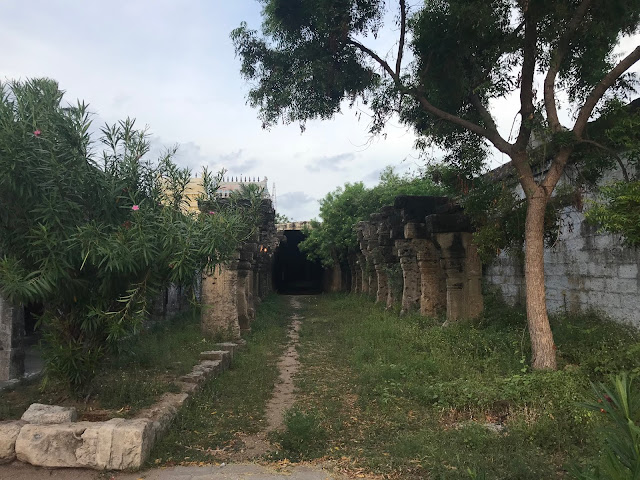*உலகின் முதல் சிவன் ஆலயம்*
*அதன் சிறப்பு தகவல்கள்*
~~~~~~~~~~~~~~~~~~~~~~~~~~
சிவனின் சொந்த ஊர், உலகிலயே முதல் நடராஜர் தோன்றிய ஊர்,
உலகின் உள்ள அனைத்து ரிஷிகள், முனிவர்கள், சித்தர்கள் வந்து வழிபாடு செய்த கோவில்.
நவகிரகங்கள் தோன்றுவதற்கு முன்னரே உருவான கோயில். நான்கு யுகங்கள் தோன்றுவதற்கு முன்னரே உருவான ஆலயம். ஆயிரம் சிவ அடியார்கள் ஒரே சமயத்தில் மோட்சம் பெற்று சகஸ்கர லிங்கம் உருவாக்கிய ஆலயம்.
3000 ஆண்டுகளாய் பூத்து குலுங்கும் இலந்தை மரம் உள்ள ஆலயம்.
*தென்னாடுடைய சிவனே போற்றி எந்நாட்டவர்க்கும் இறைவா போற்றி* என்ற வாக்கியம் உருவான இடம்.
மரகத நடராஜர் சிலை உள்ள ஆலயம். இப்படி பல அதிசயங்களையும், ஆச்சயர்களையும் தன்னகத்தே கொண்டு சாந்தமாய் இருக்கும் ஆலயம் அதுதான் இராமநாதபுரம் மாவட்டத்தில் அமைந்துள்ள திருஉத்ரகோசமங்கை மங்களநாதார் மங்களநாயகி திருக்கோவில்.
தவறாமல் இத்திருக்கோவிக்கு ஒருமுறையாவது சென்று வாருங்கள்.
இராமநாதபுரம் மாவட்டதில் அமைந்துள்ள உத்தரகோச மங்கை புனித தலம் பற்றிய 60 சிறப்பு தகவல்கள் :-
1. உத்தரகோச மங்கையில் உள்ள மூலவர் சுயம்பு லிங்கம் மூவாயிரம் ஆண்டுகளுக்கு முன்பு தோன்றியதாக கணிக்கப்பட்டுள்ளது.
2. உத்தரகோச மங்கை கோவில் சுமார் 20 ஏக்கர் பரப்பளவில் அமைந்துள்ளது.
3. உத்தரகோச மங்கையே சிவபெருமானின் சொந்த ஊர் என்று அழைக்கப்படுகிறது.
4. இத்தலத்துக்கு உமா மகேசுவரர் சன்னதி முன்பு நின்று வழிபாடுகள் செய்தால் தம்பதியர்ஒ ற்றுமை பலப்படும்.
5. திருவிளையாடல் புராணத்தில் வரும் 'வலை வீசி மீன் பிடித்த படலம்' இத்தலத்தில்தான் நடந்தது.
6. உத்தரகோச மங்கை கோவிலில் முக்கிய திருப்பணிகளை பாண்டிய மன்னர்களே செய்தனர். பாண்டிய மன்னர்கள் ஆட்சி அதிகாரத்தில்சிறந்து இருந்த போது, அவர்களது. தலைநகராக சிறிது காலத்துக்கு உத்திரகோசமங்கை இருந்தது.
7. ஆதி காலத்தில் இந்த தலம் சிவபுரம்,'தெட்சிண கைலாயம்', சதுர்வேதி மங்கலம், இலந்தி கைப் பள்ளி, பத்ரிகா ஷேத்திரம், பிரம்மபுரம், வியாக்ரபுரம், மங்களபுரி, பதரிசயன சத்திரம், ஆதி சிதம்பரம் என்றெல்லாம் வேறு வேறு பெயர்களில் அழைக்கப்பட்டது.
8. மங்கள நாதர், மங்கள நாயகி இருவரையும் வழிபடும் முன்பு அங்குள்ள பாண லிங்கத்தை தரிசனம் செய்தால் முழுமையான பலன்கிடைக்கும்.
9. இத்தலத்தில் வழிபாடுகள் செய்பவர்களுக்கு இம்மையில் அனைத்து நன்மைகளும் கிடைக்கும். மறுமையில் முக்தி கிடைக்கும்.
10. மங்கள நாதர் தலத்தில் திருமணம் செய்தால் நிறைய மங்களம் உண்டாகும் என்பது ஐதீகம். எனவே முகூர்த்த நாட்களில் நிறைய திருமணங்கள் இத்தலத்தில் நடைபெறுகின்றன.
11. மூலவருக்கு மங்களநாதர் என்ற பெயர் தவிர மங்களேசுவரர், காட்சி கொடுத்த நாயகர், பிரளயாகேசுவரர் என்ற பெயர்களும் உண்டு.
12. இறைவிக்கு மங்களேசுவரி, மங்களாம்பிகை, சுந்தரநாயகி ஆகிய பெயர்கள் உள்ளன.
13. இறைவி மங்களேசுவரி பெயரில் வ.த. சுப்பிரமணியப் பிள்ளை என்பவர் பிள்ளைத் தமிழ் பாடியுள்ளார். 1901-ம் ஆண்டு வெளியான அந்த நூல் 1956-ம் ஆண்டு மறுபதிப்பு செய்து வெளியிடப்பட்டது.
14. இத்தலத்தில் உள்ள கல்வெட்டுக்களில் ராவணனின் மனைவி மண்டோதரி பெயர் இடம் பெற்றுள்ளது. எனவே இத்தலம் ராமாயண காலத்துக்கும் முன்பே தோன்றியதற்கான ஆதாரமாக இந்த கல்வெட்டு கருதப்படுகிறது.
15. இத்தலத்தில் வேதவியாசர், காக புஜண்டர், மிருகண்டு முனிவர், வாணாசுரன், மயன், மாணிக்கவாசகர், அருணிகிரிநாதர் ஆகியோர்வ ழிபட்டு ஈசன் அருள் பேறு பெற்றுள்ளனர்.
16. இத்தலத்து பஞ்சலோக நடராஜர் மிகவும் வித்தியாசமானவர். இவர் வலது புறம் ஆண்கள் ஆடும் தாண்டவமும், இடது புறம் பெண்கள் ஆடும் நளினமான கலைப்படைப்பாக உள்ளார்.
17. கோவில் வாசலில் விநாயகப்பெருமானும், முருகப்பெருமானும் இடம் மாறியுள்ளனர்.
18. இத்தலத்து முருகனுக்கு வாகனமாக யானை உள்ளது. முருகப்பெருமானுக்கு இந்திரன் தனது ஐராவதத்தை இத்தலத்தில் அளித்தான்என்று, இத்தலமான்மியமான 'ஆதி சிதம்பர மகாத்மியம்' கூறுகிறது.
19. ராமேஸ்வரத்தில் இருந்து 83 கிலோமீட்டர் தொலைவிலும், ராமநாதபுரத்தில் இருந்து 18 கிலோமீட்டர் தூரத்திலும் இவ்வாலயம் இருக்கிறது.
20. சங்க இலக்கியத்தில் குறிக்கப்படும் "இலவந்திகைப் பள்ளி" என்பது உத்தரகோச மங்கையைக் குறிக்கும் என்கிறார்கள். மேற்குறித்த கல்வெட்டில் இலவந்திகைப் பள்ளித்துஞ்சிய நன்மாறன் பெயரும் செதுக்கப்பட்டுள்ளது.
21. மாணிக்கவாசகருக்கு உருவக் காட்சிதந்த சிறப்புடைய தலம்.
22. இலந்தை மரத்தடியில் எழுந்தருளிய மங்கைப்பெருமான் என்று இப்பெருமான் போற்றப்படுகிறார்.
23. இத்தலத்தில் சுவாமியை அம்பாள் பூசிப்பதாக ஐதீகம்.
24. சொக்கலிங்கப் பெருமான் பரதவர் மகளாகச் சபித்துப் பின் சாபவிமோசனம் செய்து அம்பாளை மணந்துகொண்டு இத்தலத்திலேயே அம்பாளுக்கு வேதப்பொருளை உபதேசம் செய்து, பின்னர் அம்பிகையுடன் மதுரை சேர்ந்ததாக மதுரைப்புராணத்தில் சொல்லப்பட்டுள்ளது.
25. ஆதிசைவர்கள் வசமிருந்த இத்தலம் பின்னரே ராமநாதபுரம் ராஜாவிடம் ஒப்படைக்கப்பட்டது. அதுமுதல் இன்றுவரை ராமநாதபுர சமஸ்தான ஆளுகைக்கு உட்பட்டதாக இருந்து வருகிறது இத்தலம்.
26. உட்பிரகாரம் நுழையும் பொழுது அழகிய வேலைப்பாடுகளுடன் காணப்படும் யாழிகளில் இரண்டு யாளிகள் வாயில் கல்லால் ஆன பந்தை கொண்டுள்ளது. நாம் கையை நுழைத்துக்கூட பந்தை நகர்த்த முடியும்.
27. இத்தலத்து கோவில் குளத்தில் வாழும் மீன்கள் நல்ல நீரில் வாழும் மீன்கள் இல்லை. கடல்நீரில் வாழும் மீன்களாகும்.
28. பிரதோஷத்தன்று இங்கு தாழம்பூ வைத்து வழிபடுகின்றனர்.இந்த கோவிலில்சிவனுக்கு அம்பாளுக்கு தாழம்பூ மாலை கட்டிப்போட்டால் அனைத்து தோஷங்களும் நீங்குவதாக ஐதீகம். இதனால் திருமணம் உடனே கைகூடும்.
29. இங்கு ஆதிகாலத்து வராகி கோவில் உள்ளது இங்கு ஒவ்வொரு வெள்ளி,செவ்வாய்.ஞாயிறு தினங்களில் ராகுகாலத்தில் பூஜை தொடர்ந்து செய்தால் தீராத பிரச்னைகள்,திருமண்த்தடை போன்றவை விலகுகின்றன.
30.ராமேஸ்வரம் வருபவர்கள் இந்த கோவிலுக்கு செல்லலாம்.
31. டெல்லியை தலைநகராகக் கொண்டு 1300-ம் ஆண்டு ஆட்சி செய்து வந்த அலாவுதீன் கில்ஜி, உத்தரகோச மங்கையில் மரகதகல்
நடராஜர் சிலை இருப்பதை அறிந்து அதை கொள்ளையடிக்க முயன்றான். மங்களநாதர் அருளால் அவன் முயற்சிக்கு வெற்றிகிடைக்கவில்லை.
32. இத்தலத்தில் தினமும் முதல் - அமைச்சரின் அன்னத்தானத்திட்டம் நடைபெறுகிறது. ரூ. 700 நன்கொடை வழங்கினால் 50 பேருக்குஅன்னதானம் கொடுக்கலாம்.
33. காகபுஜண்ட முனிவருக்கு கவுதம முனிவரால் ஏற்பட்ட சாபம் இத்தலத்தில்தான் நீங்கியது.
34. சிவனடியார்கள் 60 ஆயிரம் பேர் இத்தலத்தில் தான் ஞான உபதேசம் பெற்றனர்.
35. இத்தலத்தில் உள்ள மங்களநாதர் சன்னதி, மங்களேசுவரி சன்னதி, மரகதகல் நடராஜர் சன்னதி சகஸ்ரலிங்க சன்னதி நான்கும்தனிதனி கருவறை, அர்த்த மண்டபம், மகா மண்டபம், கொடி மரத்துடன் தனித்து இருப்பது குறிப்பிடத்தக்கது.
36. நடராஜர் மரகத கல்லில் இருப்பதால் இத்தலத்தை சிலர் ரத்தின சபை என்கிறார்கள். ஆனால் உலகின் முதல் கோவில் என்பதால்இது எந்த சபைக்கும் உட்படாதது என்றும் சொல்கிறார்கள்.
37. காரைக்கால் அம்மையாரும் இத்தலத்துக்கு வந்து ஈசனை வழிபட்டு சென்றுள்ளார்.
38. உத்தரகோசமங்கை கோவிலின் கட்டிடக்கலை திராவிட கட்டிடக்கலையை அடிப்படையாகக் கொண்டு கட்டப்பட்டதாகும்.
39. ஒவ்வொரு மாதமும் அமாவாசை, பவுர்ணமி, பிரதோஷம், கிருத்திகை, சதுர்த்தி நாட்களில் இத்தலத்தில் சிறப்பு பூஜைகள் நடத்தப்படுகின்றன.
40. சித்திரை மாதம் திருக்கல்யாண வைபவம் வைகாசி மாதம் வசந்த உற்சவம், ஆனி மாதம் பதுநாள் சிவ உற்சவம், ஐப்பதி மாதம்அன்னாபிஷேகம், மார்கழி மாதம் திருவாதிரை விழா மாசி மாதம் சிவராத்திரி ஆகியவை இத்தலத்தில் நடைபெறும் முக்கிய விழாக்கள்ஆகும்.
41. தினமும் இத்தலத்தில் காலை 5.30 மணிக்கு உஷத் காலம், 8 மணிக்கு கால சாந்தி, 10 மணிக்கு உச்சிக் காலம், மாலை 5 மணிக்கு சாயரட்சை, இரவு 7 மணிக்கு இரண்டாம் காலம், இரவு 8 மணிக்கு அர்த்தஜாம பூஜைகள் நடத்தப்படுகிறது.
42. மங்களநாதருக்கு தினமும் காலை 6 மணிக்கு, மதியம் 12.30 மணிக்கு, மாலை 5.30 மணிக்கு அபிஷேகம் நடத்தப்படுகிறது.
43. இத்தலத்தில் அதிகாலை 5 மணி முதல் மதியம் 1 மணி வரையும் பிற்பகல் 4 மணி முதல் இரவு 8 மணி வரையும் சாமி தரிசனம்செய்யலாம்.
44. மரகத கல் நடராஜர் மீது சாத்தப்பட்டு எடுத்துத் தரப்படும் சந்தனத்தை வெந்நீரில் கரைத்து குடித்தால் தீராத நோய்கள் கூட தீர்ந்துவிடும் என்பது நம்பிக்கை.
45. இத்தலத்தில் மொத்தம் 11 விநாயகர்கள் உள்ளனர்.
46. மங்களநாதர் சன்னதியை சுற்றி வரும் போது இடது பக்க மூலையில் மகாலட்சுமியை வழிபடலாம்.
47. இத்தலத்தில் உள்ள ராஜகோபுரத்தில் சர்பேஸ்வரர் சிலை உள்ளது.
48. உலகத்தில் முதலில் தோன்றிய கோவில் என்ற சிறப்பு உத்தரகோசமங்கை தலத்துக்கு உண்டு. இந்த ஆலயம் சிதம்பரம் கோவிலுக்கு முன்பே தோன்றியது.
49. நடராஜர் இங்கு அறையில் ஆடிய பின்னர்தான் சிதம்பரத்தில் அம்பலத்தில் ஆடினார்.
50. இது அம்பிகைக்கு பிரணவப்பொருள் உபதேசித்த இடம்.
51. இங்குள்ள மங்களநாதர் லிங்க வடிவில் உள்ளார்.
52. தலவிருட்சமான இலந்தமரம் மிகமிகத் தொன்மையானதும் இன்று வரை உயிருடன் உள்ளதும் பல அருள் தலைமுறைகளையும்முனிவர்கள் தரிசித்த தல விருட்சம் ஆகும். இந்த இலந்த மரம் 5000 ஆண்டுகளுக்கு முன்பு உள்ளது.
53. வேதவியாசரும், பாராசரும் காகபுஜண்டரிஜி மிருகண்டு முனிவர்கள் பூஜித்த தலம்.
54. உலகில் உள்ள 1087 சிவாலயங்களிலும் இருக்கும் அருட் சக்திகளைத் தன்னகத்தே கொண்டு விளங்கும் சகஸ்ரலிங்கம் இங்குள்ளது.
55. ஆண்டுக்கு இரண்டு திருவிழா இங்கு நடத்தப்படுகிறது. ஒன்று சித்திரைத் திருவிழா, இன்னொன்று மார்கழித் திருவாதிரைத் திருவிழா
56. இத்திருத்தலத்தில் ஒன்பது தீர்த்தங்கள் உள்ளது.
57. சிவபெருமானால் பரத நாட்டிய கலையை உலக மக்களுக்கு முதல் முதலில் அறிமுகம் செய்யப்பட்ட திருத்தலமாகும்.
58. ஈசன் ஈஸ்வரி பிறந்த ஊரான உத்திரகோச மங்கையில் ஒரு முறை பக்தர்கள் வந்து மிதித்தால் சொர்க்கம் செல்லுவது நிச்சயாமாகும்.
59. உத்தர கோசமங்கை திருத்தலமானது ஸ்ரீராமருக்கு ஈசன் சிவலிங்கம் வழங்கி சேது சமுத்திரத்தில் பாலம் போட உத்தரவு வழங்கிய இடமாகும்.
60. இத்தலத்தில் மாணிக்கவாசகர் பாடிய பொன்னூஞ்சல் பாடலை குழந்தைகளை தாலாட்டும்போது பாடினால், குழந்தைகள்
உயரமாகவும், உன்னத மாகவும் வாழ்வார்கள் என்பது பக்தர்கள் நம்பிக்கையாகும்.
*ஒம் நம சிவாயா*













